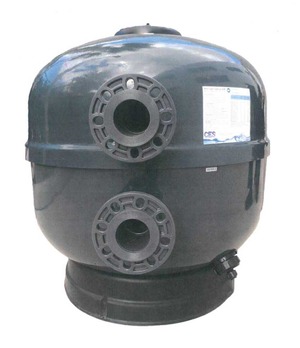
Over the years, many facilities have turned to small mass-produced sand filters, like CES’s AMF (Advanced Media Filtration) line, to handle spas, smaller pools and water features. These “production-type” tanks are normally 30-36” in diameter, are designed to handle 100-120 GPM each, and can be placed side by side to handle larger flows. The mass production lowers manufacturing costs and they are quite a bit less than larger, hand built tanks. As more and more owners and pool companies turn away from labor intensive vacuum DE filters, the importance and popularity of these smaller AMF-type filters is growing quickly, but still some folks are not sold on the technology. Why?
Simply put, many of these production filters often delivered poor results in the past including poor water quality, high pumping restrictions, frequent media replacements, and more. This gave them an undeserved bad reputation, in the eyes of many pool companies. However… to the experienced professional, nearly ALL of these issues were caused by poor equipment or system design, and poor installation and operational techniques. These mistakes can be easily and quickly corrected by following a few simple rules and promoting sound engineering practices.
Here is quick guide to long term success:
Sizing: Many of these filters are certified to operate at elevated flow rates 20GPM/Sq Ft or 140 GPM for a typical 36” filter. But one should NEVER operate these filters at that rate. Why? Simply put, the dirt and organics get driven so deeply into the filter bed, that the system cannot possibly backwash them out over time. Deep dirt catches more deep dirt, and eventually the bottom of the filter bed is ruined, and turned into a breeding ground for chlorine demand, chloramines, and even odors. Solution: One should never operate these filters higher than 15 GPM/Sq Ft or 105 GPMs each. The dirt gets caught in the upper part of the filter bed and can more easily be removed during backwash. The AMF 36” filter not only provides a larger media capacity of 7.69 Sq Ft. instead of 7 Sq Ft, but also can filter 115 GPM instead of 105 GPM at best practice flow rate maximums.
Design: Small filters rely on good hydraulics, meaning evenly distributed and balanced freely flowing water, both in the filtration mode (water going from top to bottom) and in backwash mode (water going from bottom to top). This is ONLY accomplished with proper system design. While residential applications don’t require optimum design, commercial applications do. This requires a proper amount of overhead diffusers (to spray the water evenly over the entire diameter of the filter), and ample numbers of collection laterals to provide a robust backwash flow rate to remove soils. But most filters lack one or both of these. Solution: The AMF filter line solved this by providing 3 diffusers on 36” filters (instead of one) and 12 upsized laterals on the bottom of the tank) instead of 6 or 8. This promotes the free flow of water in both directions, and allows proper media to last for many years.
Media: These filters were labeled as “sand” filters years ago, but poor sand media is a huge barrier to good water quality. Media should be highly angular, sharp, and uniform in size and shape. Most store bought media is not, with rounded shape and highly irregular size and consistency. It commonly fails filter manufacturer’s lab tests, and the rounded irregular design provides a loose “web” to catch pool dirt and debris, leading to cloudy water. CES stocked specially graded, high quality silica sand media that resolved those issues, but now we have something even better. Solution: CES’s Activated Glass Filter Media (AFM™) is made from recycled brown and green glass bottles (glad to help), and processed in highly sophisticated European factories. The media receives a permanent “activation” that prevents fouling and enhances the filtration capability. While most sand media is rated to capture 20 micron particles or larger, AFM™ can capture down to 4 microns at proper flows and sub-micron (<1.0 micron) at slower flows. It will also last the life of the filter, and is only marginally more money to install.
Piping: The final cause of small filter failures comes from poor internal piping and backwash valves design. Most failed filters use 2” internal piping and backwash valves. The max flow through a 2” line should be around 100 GPM, not 140 GPM as often used, and the restriction added by the typical multi-port valve grows exponentially as the flow rate increases. Additionally, a 2” multi-port valve often cannot process the proper amount of water in a backwash mode leading to incorrect backwash rates, media fouling, and premature media replacement. Solution: The AMF 36” comes with 2.5” (or 3”) internals and backwash valve. Best practice flow rates for 2.5’ piping is 150+ GPM (instead of 100 GPM) so the back pressure on the system is dramatically reduced, costing you a lot less in electricity annually. Also the enhanced flow rate helps backwash the filters more completely, leading to longer media life and much less frequent media replacement.
As you can see, a lot of thought went into the design of our AMF filter line, and it was not by mistake. Our unique Service Supported Distribution® (SSD®) approach puts us face to face with short and long term service issues and we have made changes in product design over the many years to assure our customers get the best water quality and the lowest possible service requirement and minimal cost of ownership.
Please contact your CES rep to find out if the AMF filter and great new AFM™ Activated Media can work for your small pool, spa, or water feature application.





